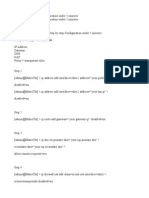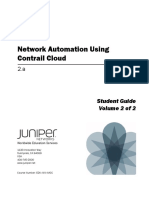0% found this document useful (0 votes)
121 views74 pagesContrail Sandbox Tutorial Script
The document provides instructions for a Contrail sandbox tutorial that demonstrates various Contrail and OpenStack configuration steps. The key steps include: logging into the lab setup, adding security rules and networks, launching VMs that cannot initially communicate, applying a network policy to allow communication, configuring floating IPs and DNS resolution, and demonstrating service chains using a firewall VM.
Uploaded by
dhkhtnCopyright
© © All Rights Reserved
We take content rights seriously. If you suspect this is your content, claim it here.
Available Formats
Download as PDF, TXT or read online on Scribd
0% found this document useful (0 votes)
121 views74 pagesContrail Sandbox Tutorial Script
The document provides instructions for a Contrail sandbox tutorial that demonstrates various Contrail and OpenStack configuration steps. The key steps include: logging into the lab setup, adding security rules and networks, launching VMs that cannot initially communicate, applying a network policy to allow communication, configuring floating IPs and DNS resolution, and demonstrating service chains using a firewall VM.
Uploaded by
dhkhtnCopyright
© © All Rights Reserved
We take content rights seriously. If you suspect this is your content, claim it here.
Available Formats
Download as PDF, TXT or read online on Scribd
/ 74

























































































